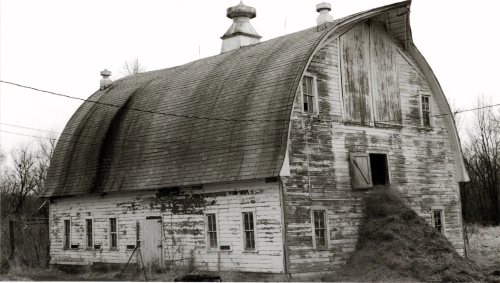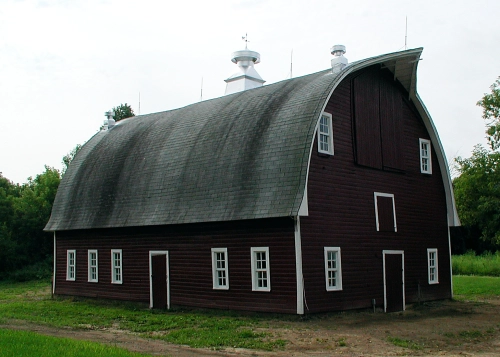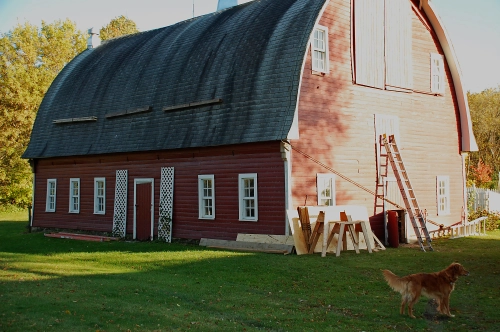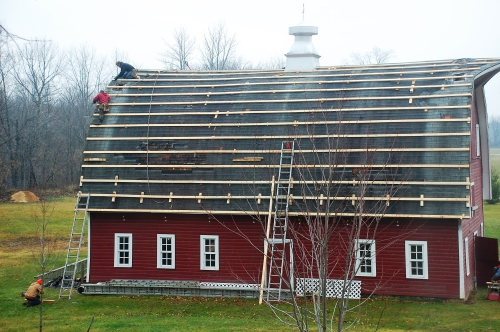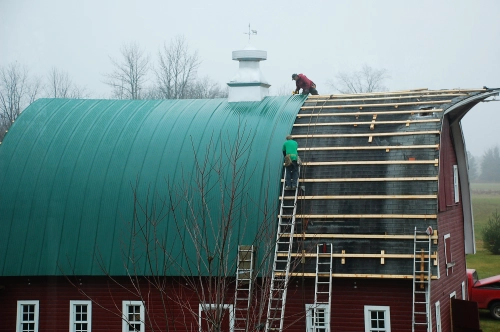We have a fairly healthy bat population in the hay loft of our barn. On summer evenings, we have stood near the barn and counted well over one hundred bats leave for their evening feed. In northern Minnesota a common bat type is the small brown bat. We have seen a few of our bats up close in the barn and they seem to be the size and description fitting the small brown bat.
Not everyone is comfortable with bats flying overhead at dusk or later sitting around the bonfire, but we have never had any problems. I think everyone is aware of how beneficial bats are for controlling mosquito and bug populations by eating as many as 5,000 bugs each night. Since our hobby farm is located along the Rum River, which has many stagnant backwater ponds, we would like to keep the bats around the farm doing their insect patrols.
While the barn has stood empty and mostly unused, we have slowly been making progress in removing calf pens and cow stanchions so that we can use the space for more garden and farm storage. The bats are mostly self-contained in the loft area of the barn, but from time to time a few of them end up in the lower area. In addition, the gaps in the floor boards of the hay loft allow bat guano to sprinkle down. So we decided that if we are going to continue to upgrade the barn, the bats needed to be relocated. Here you can see the thick layer of bat guano collecting on the hay loft floor.

Here is the main entrance for the bats into the hayloft. You can see the heavy use around the hay-fork rail where they have worn off the paint from all the flights in and out.

Although building a bat house is pretty straight forward and something we expected we would do ourselves based on plans in our “Country Wisdom & Know How” book from Storey Publishing, we also didn’t want to miss the opportunity to install the bat house before they began to return from migration. We found a design we liked from a bat conservatory organization in Michigan (
www.batconservatory.org) that uses the proceeds from the bat houses to fund their projects. Here is a picture of the bat house we ordered that has the capacity for up to 300 bats. At the bottom there is a green landing mesh that is easy for the bats to land on when they are returning to their roost.

In the next picture you can see the tight crawl spaces that the bats like for roosting. When they pack themselves into these tight spaces it helps to retain their body heat and keep each other warm in cold weather.

Our Storey book article on bats recommended “seasoning” the new bat house with guano so that it has a familiar scent. The process was to collect some guano from the hay loft and mix it with some water to create a slurry that could be poured into the bat house. This seemed kind of gross to us, but if it helps to make the bats feel comfortable in their new home then, why not?

Here is our new “well-seasoned” bat house, ready for installation.

Our research indicated that to have the best chance for relocation, the new bat house should be located as close as possible to the current bat entrance. Well, that would be high up in the peak of the barn. The extension ladder wasn’t quite long enough, so in typical farm fashion, I placed the ladder into the bucket of the tractor. This type of work isn’t for everyone. We did luck out and it was a glorious warm sunny date for February. Even warm enough to wear a short-sleeved shirt!

In order to have hands free for climbing the ladder, we attached a rope to the bat house so that it could be lifted up once I was comfortably positioned at the top.

Up comes the bat house to its new location.

It was a little dicey to hold the bat house in place and manage the screws and screw gun all at the same time. Note to self: next time start the screws in pilot holes before climbing the ladder!

Here goes nothing…..do not stand under the ladder in case I drop something!

The installation is now complete. It would be nice to have positioned the bat house a little higher, but when you are on the top of the ladder it apparently seems high enough.
The next question to answer is whether or not the bats are hibernating in the barn or if they have migrated to somewhere warmer for the winter. Since our barn has no heating or cows keeping it warm in the winter, and since there is no evidence of bat sounds on warm winter days, we believe that our bats have migrated for the winter and will return in early spring. Our research didn’t offer any definitive answers on hibernating versus migrating for small brown bats, so we will have to keep an eye out for them inside the barn. If there are bats that become trapped in the barn, then we will have to install a one-way entrance so that they can get out but cannot come back in.
Now, what are we going to do with all those other openings in the barn wall that the bats can come through? Guess we have to start plugging them all. Small brown bats can crawl through holes as small as 3/8 inch in diameter, so every hole needs to be plugged or covered. A sunny day is perfect for finding all the openings. Where to begin?
We decided that it would be easiest, low-cost, and fairly unobtrusive visually to install wire mesh over the openings – especially since there were some very large openings! We had a large roll of wire screen mesh leftover from the screened porch when we built the house. I save everything!
Wire screen mesh can be cut easily with a sharp sheet rock knife along a straight edge. I cut strips that were 6-8 inches wide the length of the screen and then installed them over the openings using a staple hammer. I used a lot of staples to make sure that the bats couldn’t find any new ways into the barn.

We will likely not have covered every possible entrance, but we hope that enough have been covered that the new bat house looks more attractive and they make that there new home.
 We should know in a few weeks whether we have been successful!
We should know in a few weeks whether we have been successful!
–Jesse
 Wherever you might live, I hope your fall has been equally as splendid. While the leaves have all fallen off the trees now, perhaps we will still be blessed with a few more days of warm temperatures and abundant sunshine. Once can always hope! 🙂
Wherever you might live, I hope your fall has been equally as splendid. While the leaves have all fallen off the trees now, perhaps we will still be blessed with a few more days of warm temperatures and abundant sunshine. Once can always hope! 🙂


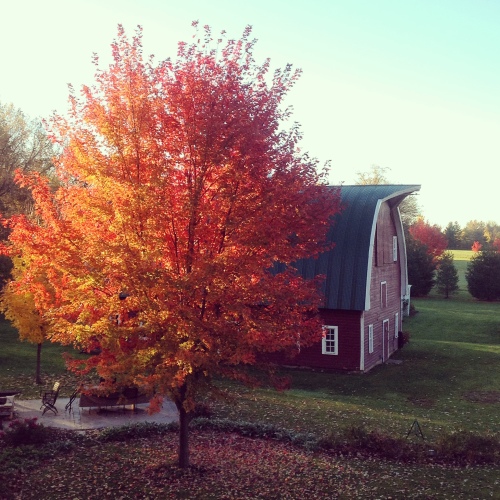




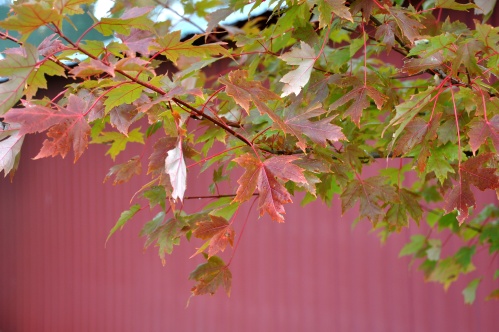





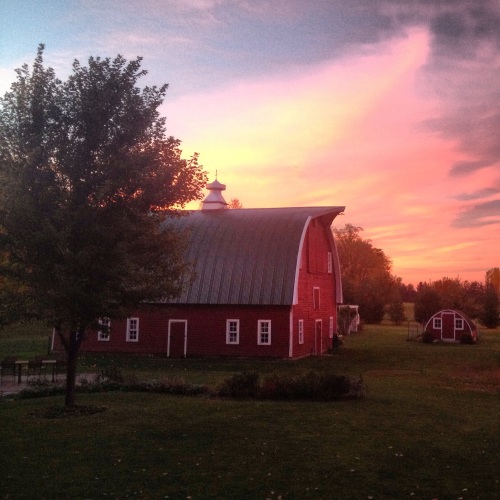


 In the next picture you can see the tight crawl spaces that the bats like for roosting. When they pack themselves into these tight spaces it helps to retain their body heat and keep each other warm in cold weather.
In the next picture you can see the tight crawl spaces that the bats like for roosting. When they pack themselves into these tight spaces it helps to retain their body heat and keep each other warm in cold weather.













